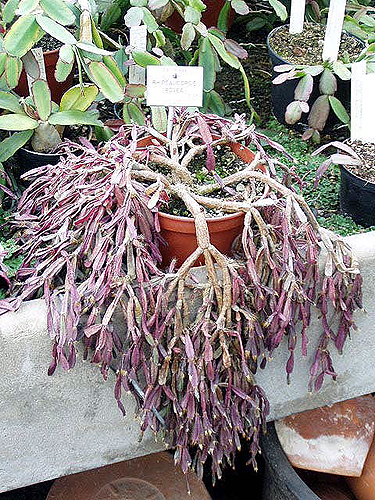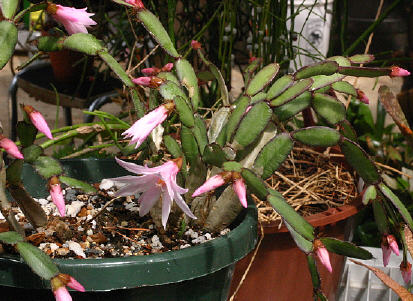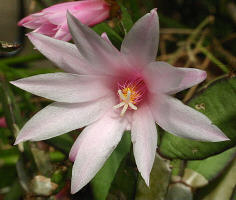
Above: H. rosea, Brussels Botanical Garden ©KAF.


Above: H. rosea (copyright Ken Friedman)
Hatiora rosea (Lagerheim) Barthlott
in Bradleya 5 (1987).
Desc from B&R 1923
- Plant - branches short, 1 to 3, strongly 4-angled or sometimes
3 or 5-angled, with concave sides;
- Buds - red;
- Flowers - 3.7 cm. broad, fra¬grant;
- Perianth-segments - few, rose-colored;
- Stamens - 11 mm. long, rose-colored;
- Style - 13 mm. long, rose-colored;
- Stigma-lobes - 3, white, 3 mm. long.
Type locality: Woods near Caiguava, state of Parana, Brazil,
altitude 1,100 to 1,300 meters.
DISTRIBUTION. Brazil (Parana, Santa Catarina, NE Rio Grande do
Sul): epiphyte, mainly on Araucaria in cloud forest, at c. 1000-2000
m altitude.
Desc from Hunt 2006
Branch segments flat or 3-5 angled, oblong or narrowly oblanceolate,
2-4 x ca 1cm, dark green, or reddish purple when exposed to sun
or cold; areoles marginal and apical, usually with fine, brown
bristles, new segments and flowers arising from apical areoles;
flowers regular, broadly funnel form, 3-4 x 3-4cm; pericarp angled;
hypanthium very short; perianth pink; stamens inserted at base
of perianth; fruit depressed globose, yellow, weakly angled.
Rhipsalis rosea Lagerh. n. sp.
by
G. LAGERHEIM
With Table 28.
Translation of original German and Latin article in Svensk Botanisk
Tidskrift, 1912, vol. 6, fasc. 3, by Peter Krebs 12/2003.
Dr. P. Dusén, who for several years has devoted himself
to botanical studies in Paraná, kindly shipped two collections
of Rhipsalideae to our local Botanical Institute in the summer
of 1911. Upon the first shipment of cuttings sent as a "trial
consignment", a box containing large rooted specimens followed.
All specimens were immediately planted in a mixture of leaf mould,
peat, bits of charcoal, pieces of plaster-lime from walls, and
a little clay and cultivated in a hothouse. Here they generally
have grown on well and some have flowered. Due to lack of time
and the absence from Stockholm I have not yet been able to determine
all forms, so now I only can give a more comprehensive report
of one of them. It represents a new species, which due to its
beautiful, flagrant flowers also deserves the interest of gardeners.
I am naming it Rhipsalis rosea.
(Latin diagnosis follows)
Rhipsalis rosea nov. spec. Table 28.
A Rhipsalis with upright stems, not growing tall, with drooping
branches (in cultivated specimens) dichotomously or trichotomously
branching out, with the lower segments often cereiform and 3-5
angled and the younger segments at first red or pale green, shiny,
later dark green, dull, fleshy, spatulate with an obtuse apex,
purple near base and apex, margins slightly crenate, with midrib
when dry, marginal areoles with a purple ring and bearing short
wool and several setae. Flowers apical from a single rather large
areole with an exserted, prismatic, tetragonal ovarium which is
narrowing at the base and naked without any scales. Perianth segments
approx. 12, the lower ones triangular, the middle and upper ones
lanceolate, acute; stamens numerous, half as long as perianth,
the style as long as or slightly longer than the stamens, dividing
into 3-4 recurved stigma lobes. Fruit unknown.
A small epiphytic shrub (or growing in a soil rich in humus in
the hothouse), usually 25 cm long, the lower part woody, up to
8 mm thick, divided into thick stem segments with greyish brown
bark. The younger segments are without bark, up to 37 mm long,
with a diameter of 2 - 3mm at the base and at the upper parts
usually 11 mm wide and 2 - 3 mm thick and slightly crenate with
2 - 3 crenations. The flower buds are red. The flowers are beautiful,
fragrant, with a diameter of 3.7 cm. The perianth segments are
rose-coloured, the lower ones 3 - 5 mm long, the middle ones approx.
12 mm long, and the upper ones 19 mm long and 6 mm wide. The stamens
are 11 mm long with rose-coloured filaments, which are tapering
towards the end, and with yolk-coloured anthers. The style is
13 mm long, rose-coloured with white, 3 mm long stigma lobes.
It is native to Brasil, at the state of Paraná near Caiguava
in the primeval forest on trunks and branches, altitude 1100 -
1300 m above sea level: collected by P. Dusén November
19th, 1909 (No. 8984, specimen in the Regnell Herbarium of the
Botanical Museum, Stockholm), and at a location not indicated,
in 1911 (living specimens in the hothouses of the University of
Stockholm); flowers in November (in the hothouse in April).
(This concludes the Latin text. The original text now continues
in German - but duly translated)
Because of the leaf-like segments, similar to Opuntia, and the
exserted ovarium the species belongs to the subgenus Phyllorhipsalis
K. Sch. Because of the clearly articulate branches it must be
put into the section Terminatae G. A. Lindb. of this subgenus.
From the other species (ref. 1) belonging here it differs by branch
segments not having a mid rib and by having terminal flowers,
among other things.
Its growth is shrubby, upright, with upright or spreading branches,
which are quite uniform. They fork out into 2-4 branches. All
of the segments are flat; when mature they have somewhat convex
surfaces and rounded margins. As with other Rhipsalis species
(ref. 2) our species develops cereiform shoots in culture. On
my specimens they appeared mostly at the lower part of the stem
(Table 28, Fig. 1, 2), grew to a length of up to 2 cm and were
3-5 angled with slightly concave surfaces. On several of the dried
specimens from Caiguava the lowermost segments of the stem were
cereiform. From the gradually narrowing base and the rounded apex
the younger segments appear more or less spatulate. Ribs are not
visible on living segments, only on dried segments a midrib is
clearly visible, secondary ribs are absent. The segments are slightly
notched at the 2-4 (usually 3) areoles. These are supported by
a tiny, red scale, which is visible only with magnification, and
are covered with very little white, later yellowish wool, and
are equipped with a few yellowish bristles, which later fall off.
At the apex of the segments the wool is more copious. The areoles
of the cereiform segments carry more bristles than the flat segments.
The not very numerous flowers emerge singly from the areoles at
the apex of the segments. They have a spreading perianth with
a diameter of up to 3.7 cm; thus they count among the largest
of the family. The sepals are beautifully rose-coloured (cf. Fig.
1 of Table 28). The flowers emit a fine fragrance, which reminds
of roses and of cedaroil. The very numerous stamens are approx.
half the length of the petals, the spreading filaments are rose-coloured,
the anthers are yolk-coloured. The reddish ovary is not immersed,
is naked, with a square section (Table 28, Fig. 4) with corners
slightly protruding; the longitudinal section is almost triangular
(Table 28, Fig. 3), approx. 5 mm long. The rose-coloured style
carries 3-4 white recurved stigma lobes, which scarcely protrude
from the anthers.
In habitat the plant flowers in November. In the hothouse the
first flower of the plants raised from cuttings opened in the
morning of April 12th, started closing at 2 p.m. and was fully
closed between 5 and 6 p.m. This repeated itself the next 3 days.
The second flower opened April 16th, 17th, and 18th, when it was
cut off. The third flower opened April 17th, 18th, 19th, 20th,
and 21st, and the fourth and last flower opened April 20th, 21st,
22nd, 23rd, 24th, and 25th. Pollination gave no results, accordingly
the species would be self-sterile (as are the other Rhipsalideae
?).
Regarding the cultivation of this recommendable species for its
large, beautiful, and fragrant flowers, it should be pointed out
that in habitat it grows at an altitude of 1100 to 1300 m above
sea level and thus doesn't need to be kept very warm. It should
also be pointed out that it throws off its segments easily, so
one should provide for sufficiently moist air; for cultivation
in the living room this plant probably is not suited.
Stockholm, October 1912.
EXPLANATIONS TO TABLE 28.
Fig. 1. Three flowering rooted cuttings, natural size.
Fig. 2. Lower part of a plant with cereiform segments; natural
size.
Fig. 3. Longitudinal section of flower; natural size.
Fig. 4. Section of ovary, magnified.
References:
1. K. Schumann, Gesamtbeschreibung der Kakteen, Neudamm 1899;
Additions 1898 to 1902, Neudamm 1903.
2. K. Goebel, Pflanzenbiologische Schilderungen (Phytological
Portrayals, in German), Part 1, p. 104, Marburg 1889.
Ex: Svensk Botanisk Tidskrift. 1912. Bd. 6, H. 3.
RHIPSALIS ROSEA LAGERH. N. SP.
von
G. LAGERHEIM
Mit Taf. 28.
Herr Dr P. Dusén, der seit Jahren in Paraná
botanischen Forschungen obliegt, hatte die Güte, dem hiesigen
botanischen Institut im Sommer 1911 zwei Sammlungen von Rhipsalideen
zu übersenden. Der ersten Sendung, Stecklinge als "Muster
ohne Wert", folgte eine Kiste mit grossen bewurzelten Exemplaren.
Sämmtliche Exemplare wurden sofort in ein Gemisch von Lauberde,
Torfstreu, Holzkohlenstückchen, Wandkalkbrocken und ein wenig
Lehm gepflanzt und im Warmhaus kultiviert. Sie sind hier im allgemeinen
gut weiter gewachsen und haben teilweise geblüht. Wegen Zeitmangel
und Abwesenheit von Stockholm habe ich bisher nicht alle Formen
bestimmen können, sodass ich jetzt nur über eine derselben
genauer berichten kann. Sie dürfte eine neue Spezies darstellen,
die wegen ihrer schönen, wohlriechenden Blüten auch
das interesse der Pflanzenzüchter verdient. Ich benenne sie
Rhipsalis rosea.
Rhipsalis rosea nov. spec. Tab. 28.
Rh. caulibus erectis, non scandentibus, ramis (in speciminibus
cultis) nutantibus, dichotomis vel trichotomis, articulis infimis
sæpe cereiformibus 3 - 5 -gonis, junioribus primum rubris
vel pallide viridibus, nitentibus, dein obscurius viridibus, opacis,
carnosis, spathulatis, apice obtusis, ad basim et ad apicem purpureis,
margine leviter crenato, in sicco nervo mediano instructis, areolis
marinalibus, purpureo-cinctis, pube brevi et setis pluribus ornatis,
floribus apicalibus, ex areola singulis, majusculis, ovario exserto,
prismatico, tetragono, ad basim attenuato, nudo, squamulis nullis,
phyllis perigonii circ. 12, infimis triangularibus, mediis et
summis lanceolatis, acutis, staminibus numerosis, dimidium perigonium
æquantibus, stilo stamina æquante vel vix superante,
in stigmata 3 - 4 recurvata diviso. Bacca ignota.
Fruticulus epiphyticus (vel in caldario in solo humoso vigens),
usque 25 cm. longus, pars inferior lignescens, ad 8 mm. crassa,
articulis angustatis, crassis, suberosis, griseo-fulvis. Articuli
juniores non suberosi, ad 37 mm. longi, basi 2 - 3 mm. diametro,
in parte superiore usque 11 mm. lati, 2 - 3 mm. crassi. Crenæ
2 - 3, levissimæ. Gemmæ florum rubræ. Flores
speciosi, diametro circ. 3,7 cm., odorati. Perigonii phylla rosea,
infima 3 - 5 mm. longa, media circ. 12 mm. longa, summa 19 mm.
longa, 6 mm. lata. Stamina 11 mm. longa, filamentis apice curvato
attenuatis, roseis, antheris vitellinis. Stilus 13 mm. longus,
roseus, stigmatibus albis, 3 mm. longis.
Habitat in Brasiliæ civitate Paraná prope Caiguava
in siva primæva ad truncos et ramos, altit. 1100 - 1300
m. s. m.: P. Dusén leg. 19 nov. 1909 (n:o 8984, spec. in
Herbario Regnelliano mus. bot. Holm.) et loco non indicato 1911
(spec. viva in caldario univ. Holm.); floret Novembri (in caldario
Aprili).
Wegen der blattartigen, Opuntia-ähnlichen Glieder und des
hervorragenden Fruchtknotens gehört die Art zur Untergattung
Phyllorhipsalis K. Sch.; wegen der deutlich gegliederten Zweige
ist sie in die Abteilung Terminatæ G. A. Lindb. dieser Untergattung
zu stellen. Sie weicht von den übrigen hierher gehörigen
Arten (Ref. 1) unter anderem durch die nervlosen Glieder und die
terminalen Blüten ab.
Der Wuchs ist strauchartig, aufrecht, mit aufrechten oder spreizenden
Zweigen, die einerlei Art sind. Sie sind gabelig verzweigt, zu
2 - 4 gestellt. Die Glieder sind sämtlich flach, ausgewachsen
mit etwas konvexen Flächen, am Rande nicht geflügelt.
Wie bei anderen Rhipsalis-Arten (Ref. 2) entstehen auch bei unserer
Art bei Kultur cereiforme Sprosse. Die erschienen an meinen Exemplaren
hauptsächlich am unteren Teil des Stammes (Taf. 28, Fig.
1, 2), wurden bis 2 cm. lang und waren 3 - 5 -eckig mit etwas
konkaven Flächen. An mehreren der getrockneten Exemplare
aus Caiguava waren die untersten Glieder des Stammes cereiform
ausgebildet. Durch die allmählich verjüngte Basis und
die abgerundete Spitze erscheinen die jüngeren Glieder mehr
oder weniger spathelförmig. Nerven sind an lebenden Gliedern
nicht sichtbar, nur an getrockneten Gliedern tritt ein deutlicher
Mittelnerv hervor, Seitennerven fehlen. Die Glieder sind an den
2 - 4 (in der Regel 3) Areolen schwach gekerbt. Diese werden von
einem winzigen, nur bei Vergrösserung sichtbaren, roten Schüppchen
gestützt, sind mit spärlichem, weissem, dann gelblichem,
äusserst kurzem Wollfilz bedeckt und mit einigen gelblichen,
abfallenden Börstchen versehen. An der Spitze der Glieder
ist der Wollfilz reichlicher. Die Areolen der cereiformen Glieder
tragen zahlreichere Börstchen als die Flachsprosse.
Die nicht sehr zahlreichen Blüten entstehen einzeln aus den
Areolen am Scheitel der Glieder. Sie sind radförmig, bis
3,7 cm. im Durchmesser und gehören also zu den grössten
der Gattung. Die Hüllblätter sind schön rosa gefärbt
(siehe Fig. 1 auf Taf. 28). Die Blüten hauchen einen feinen
Wohlgeruch aus, der an Rose und Cedroöl erinnert. Die sehr
zahlreichen Staubgefässe sind etwa halb so lang wie die Hülle,
die spreizenden Fäden sind rosenrot, die Beutel dottergelb.
Der rötliche Fruchtknoten ist nicht eingesenkt, nackt, im
Querschnitt viereckig (Taf. 28, Fig. 4) mit ein wenig hervorragenden
Ecken, im Längsschnitt fast triangulär (Taf. 28, Fig.
3), ungefähr 5 mm. lang. Der rosenrote Griffel trägt
3 - 4 weisse zurückgekrümmte Narben, die die Staubfäden
kaum überragen.
In der Heimat blüht die Pflanze im November. Die erste Blüte
der im Warmhaus kultivierten Stecklingpflanzen entfaltete sich
am 12 April des Morgens, fing an, sich um 2 Uhr zu schliessen
und war zwichen 5 und 6 Uhr ganz geschlossen. Dieser Vorgang wiederholte
sich noch weitere 3 Tage. Die zweite Blüte öffnete sich
am 16, 17 und 18 April und wurde dann abgeschnitten. Die dritte
Blüte entfaltete sich am 17, 18, 19, 20 und 21 April, die
vierte und letzte Blüte am 20, 21, 22, 23, 24, 25 April.
Befruchtungsversuche misslangen, die Art dürfte demnach (wie
die übrigen Rhipsalideen ?) selbststeril sein.
Die Kultur betreffend dieser durch ihre grossen, schönen
und wohlriechenden Blüten empfehlenswerten Art sei bemerkt,
dass sie in der Heimat in einer Höhe von 1100 bis 1300 m.
ü. M. wächst und also nicht sehr warm gehalten zu werden
braucht. Es mag ferner hervorgehoben werden, dass sie ihre Glieder
sehr leicht abwirft, sodass man für genügend feuchte
Luft sorgen muss; zur Kultur in Wohnzimmern eignet sich deshalb
die Pflanze wahrscheinlich nicht.
Stockholm im October 1912.
ERKLÄRUNG DER TAFEL 28.
Fig. 1. Drei blühende Stecklingpflanzen in natürlicher
Grösse.
Fig. 2. Unterer Teil einer Pflanze mit cereiformen Gliedern; nat.
Grösse.
Fig. 3. Blüte im Längsschnitt; nat. Grösse.
Fig. 4. Fruchtknoten im Querschnitt, vergrössert.
Ref.:
1. K. Schumann, Gesamtbeschreibung der Kakteen, Neudamm 1899;
Nachträge 1898 bis 1902, Neudamm 1903.
2. K. Goebel, Pflanzenbiologische Schilderungen, Teil 1, S. 104,
Marburg 1889.
|


